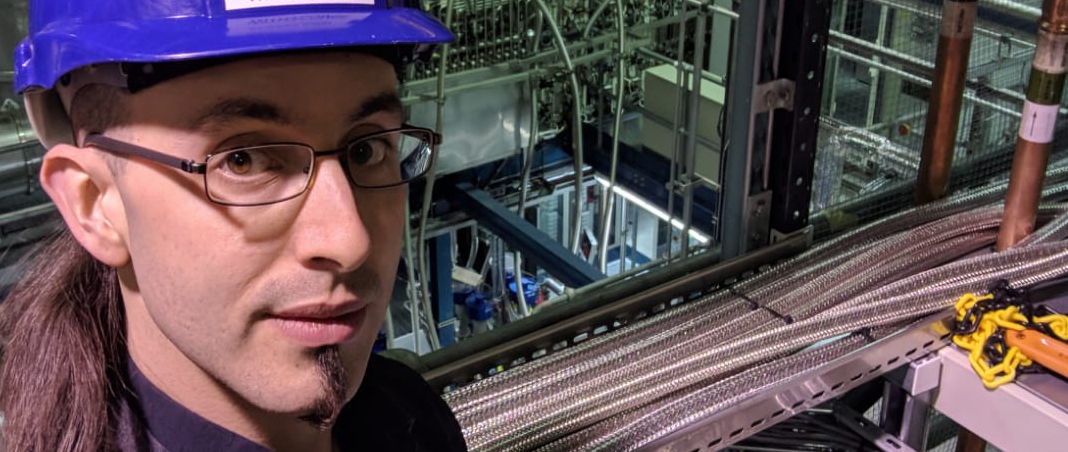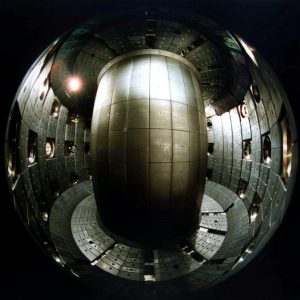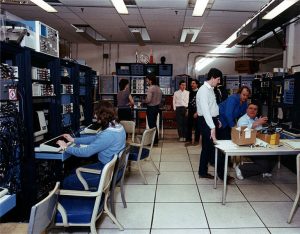
Science- based selfie! The lovely Alex at work…
I bribed my scientist friend, Alex, with pints of lager to talk about his exciting and mysterious career as a Nuclear Fusion Engineer. Turns out he’s involved in literally saving the planet by making green power from nuclear fusion- nice!
I imagined lasers (*pew, pew*), pressure suits (one small step for man…), and many beeping instruments and dials (I’m afraid I can’t do that, Dave)
I’ve known Alex for almost a decade, and have to confess that I’ve only very vaguely understood what he does at work. His job always sounded fitting with his Cyber Goth profile- I imagined lasers (*pew, pew*), pressure suits (one small step for man…), and many beeping instruments and dials (I’m afraid I can’t do that, Dave), but I still had no real idea what he was doing. Turns out he’s part of a global team of specialists at an experimental research facility working on generating carbon-free, clean energy from nuclear fusion. So just your regular saving-the-planet-for-future-generations type stuff… Massive hero- I will buy you a beer more often!
Read on to delve into the challenges and rewards of a career in practical, cutting-edge science, with a bit of GCSE science revision mixed in…
What is your job title? I’m hoping for something close to “Overlord of the Bunsen Burner, Master of the Fume Cupboard”…
Nearly… my official job title is “Tritium Plant Engineer”
OK, that’s cool too, I guess…How would you describe your role in layman’s terms?
This does involve bleeping instruments… on a bad day anyway!
I work at an experimental nuclear fusion plant and research facility called JET, which stands for Joint European Torus. I help maintain the operation of the plant, and contribute to research on tritium, the special isotope of hydrogen used in nuclear fusion reactions. I’m responsible for maintaining the active gas handling facility- this does involve bleeping instruments… on a bad day anyway!
I also write research papers and present at conferences. Our research feeds into the international work on fusion, particularly preparations for the largest fusion facility in the world in France, the ITER [International Thermonuclear Experimental Reactor]. I’m also responsible for running the conference of the UK Tritium Users Group, or TUG… yes, lots of comedy acronyms in this field!
Wow that sounds very interesting and complicated- can you explain a bit more about nuclear fusion and its potential as a green energy source please?
Unlike nuclear fission, which involves splitting atomic nuclei to release energy, nuclear fusion is a process by which nuclei are squeezed together close enough to form new, larger nuclei, releasing subatomic particles and large amounts of energy. This mechanism powers stars, though we achieve the required conditions slightly differently here on Earth! Our major fuel gases are deuterium and tritium, which are heavier isotopes of hydrogen. We generate these nuclear reactions in a chamber called a Tokamak, which contains the reaction using really powerful electromagnets.

Inside a Tokamak! Courtesy of CRPP-EPFL, Association Suisse-Euratom (source: Wikimedia Commons)
The benefits of fusion over fission are that there is much less waste material (mostly just compressed rubber gloves at the moment!) and tritium has a much shorter half life, so will decay much faster than uranium (12.32 years compared to thousands for uranium).
The issue is that we have to use more energy in generating the nuclear reaction than we get out in power, so it’s not currently in use as a commercial energy production source. Research has been going since the 1950s, and we’ve progressed to achieve about 80% energy produced to that put in. The ITER facility aims to produce 10 times more energy than is inputted, hopefully by 2050, so the future is super exciting.
Are there any frequent misconceptions about your job?
It’s actually pretty safe: if something goes wrong, the reaction will just stop
That fusion is dangerous. It’s actually pretty safe: if something goes wrong, the reaction will just stop as it requires very specific temperature, pressure, and magnetic conditions. There is also much less fuel involved, so heat generation can be stopped quickly, and no chain reaction process, so there is no risk of catastrophic explosive events unfortunately seen in fission reactors like Chernobyl.
Good to hear! What does your “typical day’ look like?
We have a 7.45am start at the plant, so I’m up around 6.30am, which is pretty painful to be honest! I get going with a protein shake, and head out in the car with my housemate who works in a different part of the same plant [car sharing too- extra green points for you!]. We listen to audio books in the car- usually Sci-Fi or fantasy like Terry Pratchett novels!
When I get in, I meet with the Technician I manage and set him up for the day with tasks. At the moment we’re working on updating the fuel cycle plant [called a “Tokamak” in this field- yes, I’ve been on Wikipedia!] to handle larger loads and provide better analytical support. In particular, JET pioneers research in gas handling: hydrogen is difficult to deal with in gaseous state, as it tends to escape through metal containers, something that gets even worse when it is heated, but kinda essential for generating energy. My working days are largely spent fault finding on equipment. I often have to design new equipment to solve these problems or optimise gas flow processes, and then fill out safety paperwork on these new designs.

What science looked like in the 1980s… The control room of the Alcator C Tokamak at the MIT Plasma Science and Fusion Center, in c.1983 (source: Wikimedia Commons)
Once the plant is fully operational, we’ll be on 24 hour shifts to supervise the experiments running for our’s and other teams at the plant. At the moment though, I finish around 4pm, drive home and hit the gym, go climbing, gaming, or Blues dancing.
What are the best bits of your job?
I really enjoy my job! I like the variety and the challenge of problem solving each day- there’s always something new! It’s also nice to think you’re contributing to something that’s genuinely useful for the world and might help in future.
I enjoy being part of an international team- we have people from Greece, Croatia, Germany, Russia, France- it’s really exciting to coordinate with these large teams to get things done. We also employ above the national average of women in STEM careers, so it feels like an inclusive place too which is important to me.
Brief interlude for some key sciency terms- skip down for more fun interview bits- no judgement 😉
| Nuclear fission | The process in current nuclear power plants, in which a free neutron is collided with nucleus of a radioactive atom like uranium or plutonium. This collision splits the atoms, which generates energy to heat water, create steam, and drive turbines to convert into electricity. It also generates radioactive waste as a byproduct (largely water). |
| Nuclear fusion |
Instead of using uranium atoms like fission, fusion uses heavy hydrogen atoms found in water (tritium) to generate nuclear reactions and energy. Fusion is essentially the process going on in the sun: the sun is a ball of gas that has been turned into plasma because of its giant mass which creates intense pressure and heat at the core. To reproduce a mini sun on earth, gas atoms are spun very quickly at high temperatures to create plasma, and then tritium atoms are slammed into each other to create fusion reactions and energy generation. |
| Tritium | The special “heavy” isotope of hydrogen used in fusion. Tritium is radioactive and difficult to find. |
| Tokamak | A Russian acronym for “torus shaped, magnetic chamber, surrounded by coils”- catchy… First designed in the 1950s, a Tokamak is essentially a container for fusion: the powerful magnetic fields generated by the electromagnets in the Tokamak work to contain the plasma in which fusion reactions occur. |
| ITER |
International Thermonuclear Experimental Reactor (also Latin for “the way”). This is the largest Tokamak in the world. Japan, South Korea, UK, USA and France collaborate on this. The ultimate goal is to produce ten times the energy in the reactions than it takes to heat up the plasma- ten times more energy out than is put in. |
| JET |
Joint European Torus- the facility where Alex works. They test equipment within their Tokamak (the Torus) to be used at the large ITER plant when this is operational. In 1997, JET produced a peak of 16.1MW of fusion power (65% of heat to plasma), which was then, a world record. |
What are the biggest challenges in your job?
I’d say the paperwork involved in public and EU funded projects like ours can sometimes slow things down- I think this is a pretty common experience! It can also be challenging to describe my equipment designs to non-experts on design panels. There is some uncertainty in the future because of Brexit. We’re unsure about what will happen with regulations as well as funding- fingers crossed!
What are you most proud of in your career so far?
I’m proud that I’ve been able to push myself in new ways in this job. I’ve delivered large scale engineering projects, handle rare materials on a day-to-day basis, and have created one of a kind solutions to entirely new problems in the field. I have great opportunities here.
How did you get into this career?
I thought I might get a tour at least- it worked out pretty well!
It was largely by accident actually! I was in to science at school and decided to do a degree in Chemistry at the University of Reading. I did OK, not great, as I wasn’t so strong at exams, but knew my strengths were in practical elements of Chemistry- the slower, methodical stuff that is real-world lab work. After graduating I took an analytical technician role at BP as it looked interesting. I stayed there for 3 years, then saw an advert for the JET facility. I applied and I thought I might get a tour at least- it worked out pretty well!
Any advice to others wanting to follow a career in practical science?
Develop and value your people skills – they are just as important as academic skills. For me, I’m not the strongest at maths, but I work in a team of 600-800 people, so I need to find out who is strong with maths and work with them to come up with solutions. There’s a lot of team work in practical science, so working on and talking about these skills in applications should help.
There’s also a lot of patience involved! – patience with paperwork, others in your team, non-experts… A genuine interest and passion will help you through those times.
Thanks Alex, that’s been much more educational than my usual pub visits! Good luck with the research!
To find out more, check out the JET website and YouTube channel here. They even run tours of the facility if you’re super keen (here) 🙂
Thanks for reading! Hit Follow to receive brief notes letting you know that I’ve posted a new article, and in the meantime, check out the Instagram and YouTube channels for more (Un)Popular content!